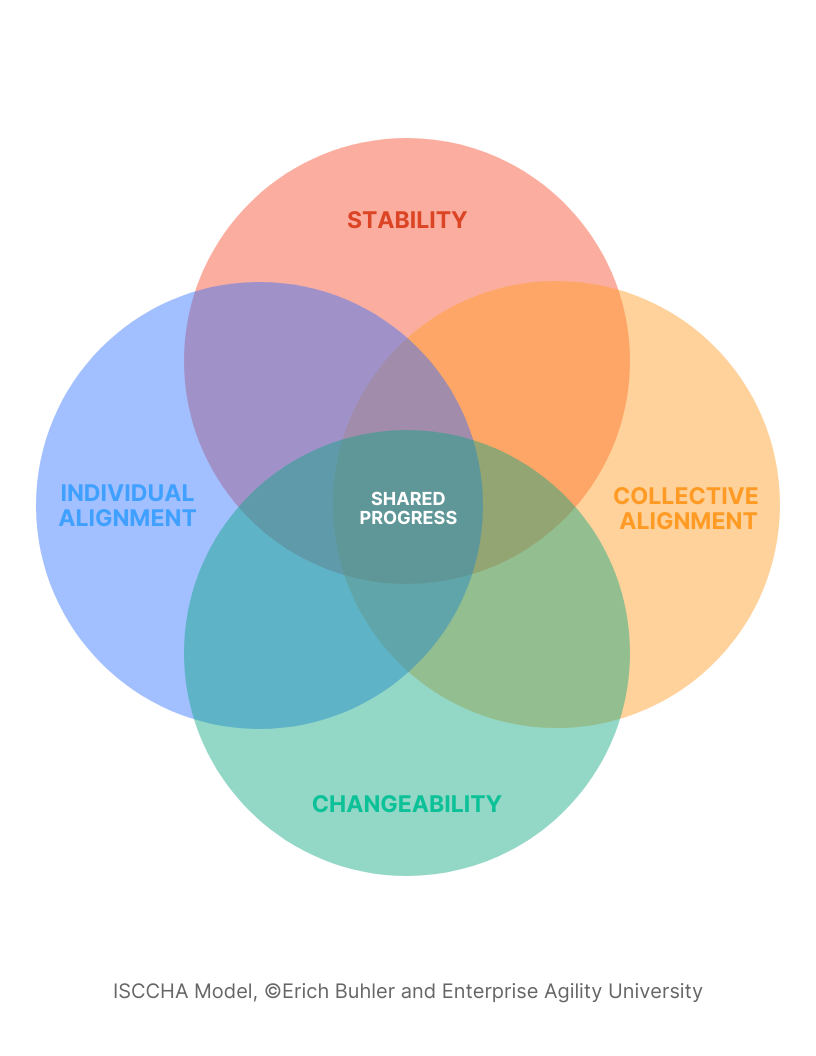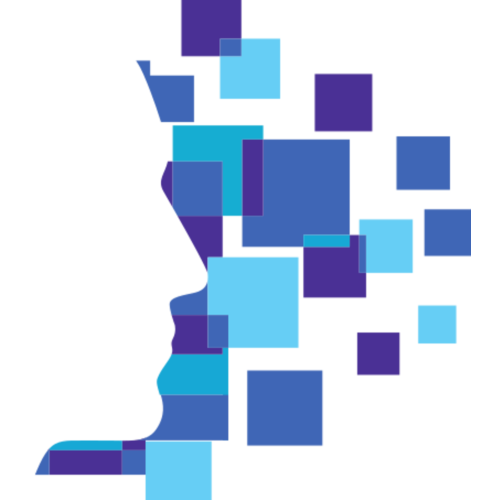In today's era of exponential change, companies must navigate near-constant disruption and transformation. Entire industries can be radically reshaped seemingly overnight by emerging technologies, competitors, and shifting market forces. To stay competitive, organizations must become highly flexible and resilient, and be able to adapt both strategically and operationally when conditions change. But transformation cannot happen without people. Aligning teams and individuals with a new reality during turbulent times is critical, yet incredibly challenging. Enterprise Agility offers several models to help individuals deal with new situations, such as the Lead Myself model, which specifically helps executives and leaders deal with the new accelerated reality. We also provide the Change Journey Pyramid to solve systemic situations in the company.
Another option is the ISCCHA (pronounced ISKA) model. It is specifically tailored to help change professionals better understand how to help individuals and groups in organizations.
ISKA provides a framework for steering individuals and teams through disruption by focusing on meeting individual needs across four interdependent dimensions: Individual Alignment, Collective Alignment, Changeability, and Stability.

Individual Alignment prepares each person for the specific changes ahead based on their unique capabilities and needs and is related to the Individuals Aspect—an important pillar in Enterprise Agility. Collective Alignment realigns individuals with the organizational vision, strategy and goals. Changeability enables people to adjust to new external disruptive situations overall. Stability provides anchors to make people feel emotionally, mentally and psychologically safe during turbulence.
By integrating these multiple perspectives, ISKA offers a holistic approach for alignment and transformation enablement. The model illuminates the most effective path forward to shared progress.
As disruption accelerates, mastering alignment is key to organizations navigating change and emerging stronger. In this article, we will explore how the ISKA model empowers teams to steer through the storm.
- Individual Alignment: Prepares each person for the specific upcoming changes based on their unique capabilities and needs. Involves tailored communication, coaching, training, and leveraging AI/tools to help them understand, visualize and feel empowered in their new role.
- Stability: Provides what individuals need to feel emotionally, mentally and psychologically stable through establishing anchors amidst turbulence.
- Collective Alignment: Helps individuals realign with the team, stakeholders, and new strategy under the renewed reality. Optimizes dynamics for cohesion towards the vision and goals.
- Changeability: Provides what individuals/teams/stakeholders or the company need at a general level to be able to adapt to the new external situation and highly changing environment overall.
Let's take a closer look at each dimension:
Individual Alignment
Individual Alignment is the first critical dimension of the ISKA framework and involves preparing each employee for upcoming changes based on their specific needs and capabilities. It entails a deep two-way communication process to uncover concerns, doubts, or any potential resistance to the changes. Assessing knowledge and skill gaps in relation to the future state is also a key aspect.
Individual Alignment focuses on providing support so that each person clearly understands why the changes are happening, what the impact will be, and can visualize their evolving role in the new reality. It is about addressing fears transparently and empowering people with the right mindsets and capabilities to feel aligned intellectually and emotionally with the transformation journey ahead. An important part of Individual Alignment is for the person to have the needed AI or any other tools to magnify their skills.
There is also a psychological and emotional aspect to Individual Alignment. Change can be stressful, and liberating new performance levels requires energizing people positively. This means uncovering both rational and emotioxnal barriers to alignment and providing coaching and training to overcome them. Ultimately, Individual Alignment ensures that unique needs are met at a granular level so that every single person feels seen, heard, empowered, and part of the group.
Collective Alignment
While Individual Alignment focuses on preparing each employee, Collective Alignment involves realigning individuals with the broader organization—teams, stakeholders, structures and strategy—to work cohesively towards the renewed vision and goals.
This entails evaluating and optimizing everything needed to effectively collaborate and align collectively in the new reality. It means assessing team dynamics and social networks to uncover opportunities for better information sharing, cooperation, and participatory decision-making.
Collective Alignment also requires examining organizational and team structures to eliminate silos and bottlenecks that hinder communication and alignment. This may involve redesigning workflows, processes, and policies to be more adaptive. Social spaces and rituals that bring people together physically and virtually also play a key role.
In essence, Collective Alignment ensures that the overarching human system is realigned, engaged and cohesive. With a psychologically safe environment and focus on shared goals, resistance is reduced, social agility is increased, and synergy unlocked. It enables people to converge and thrive together.
Stability
The Stability dimension acknowledges that people require a sense of safety and security—especially amidst turbulent change. It focuses on establishing anchors that provide the requisite degree of stability for people to stay balanced and productive during transitions.
At an organizational level, this involves identifying and retaining some familiar structures, routines or social connections that give staff continuity. Communicating reasons for change and how they align with values provides reassurance. Guaranteeing job security alleviates worries about the unknown. Providing outlets for concerns and active listening shows people they are heard.
At an individual level, coaching helps identify what gives each person stability. Accommodating these needs fuels resilience. Assessments can identify those requiring more customized stability support.
Stability also involves making people feel psychologically and emotionally safe during change. Ensuring open communication, empathy and compassion from leaders and colleagues creates a sense of care. Respecting emotions by allowing expression of doubts and fears in a judgement-free space provides safety.
Essentially, Stability supports people holistically—practically and psychologically. By creating an emotionally safe environment amidst change, transformation becomes smoother. Deliberately addressing stability needs allows people to stay grounded, engaged and positive when facing the unknown.
Changeability
The Changeability dimension focuses on providing individuals/teams/stakeholders or the company with what they need to adjust and thrive in the new, ever-changing and accelerated environment. Changeability is also a Spot Indicator in TVC.
At an organizational level, Changeability involves providing the right technologies, tools and infrastructure to help the person to rapidly sense and adapt to new market conditions or demands.
Essentially, Changeability gives people the self-efficacy and resources to feel comfortable with continuously changing situations. By cultivating adaptable mindsets and capabilities at individual and organizational levels, the company develops true responsiveness—the ability to flex, transform and progress through whatever arises.
ISKA and the Three Universal Outcomes of Enterprise Agility
ISKA also aligns with the Three Universal Outcomes of Enterprise Agility in several ways.
Always Ready Outcome
Individual Alignment relates strongly to being Always Ready. Preparing each person for upcoming changes based on their needs enables readiness at an individual level.
Always Responsive Outcome
Collective Alignment correlates with being Always Responsive. Realigning people collectively with the new vision and strategy allows teams to respond effectively together.
Always Innovative Outcome
Changeability aligns closely with being Always Innovative. Enabling individuals and organizations to adapt to changing situations fosters the agility for ongoing innovation. Changeability is also a Spot Indicators in TVC.
Stability provides an important foundation for them all. By giving people the support they need in the midst of change, it fosters readiness, responsiveness, and overall innovation to build Shared progress.
In summary, there are clear relationships between Individual Alignment, Collective Alignment, Changeability and the Three Universal Outcomes. Stability acts as an overarching enabler. Adopting a multi-dimensional approach like ISKA allows an organization to boost strategic mobility and progress towards the outcomes holistically.
